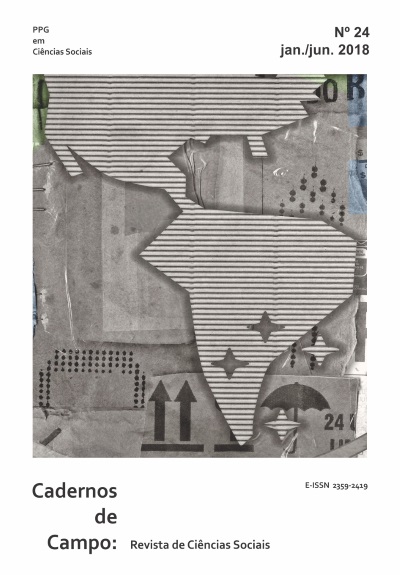The international monetary hierarchy and the financialization of peripheral countries: an interpretation on Brazil
Keywords:
Financialization, Globalization, Emerging Countries, Dollar,Abstract
The present paper begins by analyzing the literature on the phenomenon of financialization in emerging countries. It is hypothesized that the global dependence of the US dollar generates a global cycle of liquidity that creates a series of “impulses” to financialization in emerging countries. In interaction with domestic actors and institutions, these impulses are amplified and not only leave emerging countries more vulnerable to changes in capital flows, but also shape the credit markets and the way in which non-financial corporations are indebted. In this sense, the case of Brazil is analyzed in order to exemplify such dynamics. It is argued that ‘financialization’ in peripheral countries is a qualitatively diverse phenomenon because of the position of these countries in the international financial and monetary hierarchy.
Downloads
References
ARRIGHI, G. The Long Twentieth Century: Money, Power, and the Origins of Our Times. London: Verso, 2010.
BARAN, P.; SWEEZY, P. Monopoly Capital: an essay on the american economic and social order. New York: NYU Press, 1966.
BANCO CENTRAL DO BRASIL [BCB]. Indicadores de crédito. 2018. Disponível em: <https://www3.bcb.gov.br/sgspub/localizarseries/localizarSeries.do?method=prepararTelaLocalizarSeries>. Acesso em: 14 fev. 2018.
BIS. Triennial Central Bank Survey Of Foreign Exchange And OTC Derivatives Markets In 2016. 2017a. Disponível em: <https://www.bis.org/publ/rpfx16.htm>. Acesso em: 17 fev. 2018.
BIS. Debt Securities Statistics. 2017b. Disponível em:<http://www.bis.org/statistics/secstats.htm>. Acesso em: 17 fev. 2018.
BIS. Locational Banking Statistics. 2017c. Disponível em:<https://www.bis.org/statistics/bankstats.htm>. Acesso em: 17 fev. 2018.
BONIZZI, B. An Alternative Post-Keynesian Framework for Understanding Capital Flows to Emerging Markets. Journal of Economic Issues, New York, v. 51, n. 1, p.137-162, jan. 2017.
BONIZZI, B. Financialization in Developing and Emerging Countries. International Journal Of Political Economy, New York, v. 42, n. 4, p.83-107, 2013.
BOYER, R. Is a finance-led growth regime a viable alternative to fordism? a preliminary analysis. Economy & Society, Abingdon, v. 29, n. 1, p. 111-145, 2000.
BRAGA, J. C. et al. For a political economy of financialization: theory and evidence. Economia e Sociedade, Campinas, v. 26, p.829-856, dez. 2017.
BRUNO, M. et al. Finance-Led Growth Regime no Brasil: estatuto teórico, evidências empíricas e consequências macroeconômicas. Revista de Economia Política, São Paulo, v. 31, n. 5, p.730-750, 2011.
BRUNO, V.; SHIN, H. S. Capital flows and the risk-taking channel of monetary policy. Journal of Monetary Economics, Amsterdam, v. 71, p.119-132, abr. 2015.
CARVALHO, F. J. C. de. The Recent Expansion of Foreign Banks in Brazil: First Results. Latin American Business Review, Philadelphia, v. 3, n. 4, p.93-119, set. 2002.
CEMEC. Indicadores De Endividamento E Capacidade De Pagamento Das
Empresas Não Financeiras. 2017. (Nota Cemec, 6.). Disponível em: <http://cemecfipe.org.br/wp-content/uploads/2018/02/NOTA-CEMEC-06-2017.pdf>.Acesso em: 6 nov. 2018.
CHESNAIS, F. O capital portador de juros: acumulação, internacionalização, efeitos econômicos e políticos. In: CHESNAIS, F. (Org.). A finança mundializada: raízes sociais e políticas, configuração, conseqüências. São Paulo: Boitempo, 2005. p. 35-67.
CHESNAIS, F. A globalização e o curso do capitalismo de fim-de-século. Economia e Sociedade, Campinas, v. 5, p.1-30, 1995.
CHUI, M.; KURUC, E.;TURNER, P. A New Dimension to Currency Mismatches in the Emerging Markets - Non-Financial Companies. BIS Working Paper, Basel, n.550. 2016. Disponível em <https://ssrn.com/abstract=2749312>. Acesso em: 16 fev. 2018.
COHEN, B. J.; BENNEY, T. M. What does the international currency system really look like?. Review of International Political Economy, Abingdon, v. 21, n. 5, p.1017-1041, dez. 2013
CONTI, B. M. de. Políticas Cambial e Monetária: os Dilemas Enfrentados por Países Emissores de Moeda Periféricas. 2011. 216 f. Tese (Doutorado em Economia) - Instituto de Economia, Universidade Estadual de Campinas, Campinas, 2011.
CONTI, B. M. de; PRATES, D. M.; PLIHON, D. A hierarquia monetária e suas implicações para as taxas de câmbio e de juros e a política econômica dos países periféricos. Economia e Sociedade, Campinas, v. 51, n. 2, p.341-372, ago. 2014.
CONTI, B. M. de; PRATES, D. M.; PLIHON, D. O Sistema Monetário Internacional e seu Caráter Hierarquizado. In: CINTRA, M. A. M.; MARTINS, A. R. A. As transformações no sistema monetário internacional. Brasília: Ipea, 2013. p. 23-85.
CORREA, E.; VIDAL, G.; MARSHALL, W. Financialization in Mexico: trajectory and limits. Journal of Post Keynesian Economics, Philadelphia, v. 35, n. 2, p.255- 275, jan. 2012.
CORRÊA, M; LEMOS, P; FEIJO, C. Financeirização, empresas não financeiras e o ciclo econômico recente da economia brasileir. Economia e Sociedade, Campinas, v. 26, n. 1, p.1129-1150, dez. 2017.
EPSTEIN, G.A. Financialization and The World Economy. Cheltenham: Edward Elgar, 2005.
FAMA, E. F. Efficient capital markets: A review of theory and empirical work. The Journal of Finance, Hoboken, v. 25, n.2, p.383-417, 1970.
FOSTER, J. B. The Financialization of Accumulation. Monthly Review, New York, v. 62, n. 5, out. 2010.
FOSTER, J. B. The Financialization of Capitalism. Monthly Review, New York, v. 8, n. 11, abr. 2007.
FOSTER, J.; MAGDOFF, F. Stagnation and Financialization: The Nature of the Contradiction. Monthly Review, New York, v.66, n.1, 2014.
FOSTER, J.; McCHESNEY, R. The Endless Crisis: How Monopoly Finance Capital Produces Stagnation and Upheavel from the USA to China. New York: Monthly Review Press, 2012.
GABOR, D. The financialisation of the Romanian Economy: from central
bank-led to dependent financialization. Leeds: FESSUD Studies, 2013. (Studies in Financial Systems, 5.).
GUTTMANN, R. Finance-Led Capitalism: Shadow Banking, Re-Regulation, and the Future of Global Markets. New York: Palgrave Macmillan, 2016.
GUTTMANN, R. A primer on finance-led capitalism and its crisis. Revue de la Regulation, Grenoble, v.3, n.4, p.1-19, 2008.
INTERNATIONAL MONETARY FUND [IMF]. Currency Composition of Official Foreign Exchange Reserves. 2017a. Disponível em <http://data.imf.org/?sk=E6A5F467-C14B-4AA8-9F6D-5A09EC4E62A4>. Acesso em: 6 nov. 2018.
INTERNATIONAL MONETARY FUND [IMF]. Global Financial Stability
Report: Is Growth at Risk?. Washington, DC, Oct. 2017b.
INTERNATIONAL MONETARY FUND [IMF]. Annual Report On Exchange
Arrangements And Exchange Restrictions. Washington, 2016. Disponível em: <https://www.imf.org/en/Publications/Annual-Report-on-Exchange-Arrangementsand-Exchange-Restrictions/Issues/2017/01/25/Annual-Report-on-ExchangeArrangements-and-Exchange-Restrictions-2016-43741>. Acesso em: 6 nov. 2018.
INSTITUTO DE PESQUISA ECONÔMICA APLICADA [IPEA]. Investimento
real. 2017. Disponível em: <http://www.ipeadata.gov.br/ExibeSerie.aspx?serid=38406>. Acesso em: 17 fev. 2018.
KALTENBRUNNER, A. A post Keynesian framework of exchange rate determination: a Minskyan approach. Journal of Post Keynesian Economics, Philadelphia, v. 38, n. 3, p.426-448, out. 2015.
KALTENBRUNNER, A.; LYSANDROU, P. The US Dollar’s Continuing Hegemony as an International Currency: A Double-matrix Analysis. Development And Change, Chichester, v. 48, n. 4, p.663-691, jun. 2017.
KALTENBRUNNER, A.; PAINCEIRA, J. P. Subordinated Financial Integration and Financialisation in Emerging Capitalist Economies: The Brazilian Experience. New Political Economy, Abingdon, p.1-24, jul. 2017.
KALTENBRUNNER, A.; PAINCEIRA, J. P. Developing countries’ changing
nature of financial integration and new forms of external vulnerability: the Brazilian experience. Cambridge Journal of Economics, Oxford, v. 39, n. 5, p.1281-1306, out. 2014.
KARACIMEN, E. Consumer Credit as an Aspect of Everyday Life of Workers in Developing Countries. Review of Radical Political Economics, Thousand Oaks, v. 48, n. 2, p.252-268, jul. 2015.
KARWOWSKI, E.; STOCKHAMMER, E. Financialisation in emerging economies: a systematic overview and comparison with Anglo-Saxon economies. Economic and Political Studies, Abingdon, v. 5, n. 1, p.60-86, jan. 2017.
LAPAVITSAS, C. Profiting Without Producing: How Finance Exploits Us All.
Londres: Verso, 2014.
LAVINAS, L. The takeover of Social Policy by Financialization: the Brazilian paradox. Rio de Janeiro: Palgrave Macmillan, 2017.
LEVINE, R. Foreign banks, financial development, and economic growth. In: BARFIELD, C. International Financial Marketsv. Washington, DC: Aei Press, 1996. p. 224-255.
PALMA, J.G. Why corporations in developing countries are likely to be even more susceptible to the vicissitudes of international finance than their counterparts in the developed world: A Tribute to Ajit Singh. Cambridge Working Papers in Economics, Cambridge, n.1539, dez. 2015.
PAULA, L. F. de; FRITZ, B.; PRATES, D. M. Keynes at the periphery: Currency hierarchy and challenges for economic policy in emerging economies. Journal of Post Keynesian Economics, Philadelphia, v. 40, n. 2, p.183-202, abr. 2017.
PELLEGRINI, J.A. As operações compromissadas do Banco Central. Estudo
Especial, Brasília, n.3, 2017. Disponível em: <https://www12.senado.leg.br/ifi/pdf/estudo-especial-no-03-as-operacoes-compromissadas-do-banco-central-out-2017>.
Acesso em: 6 nov. 2018.
PRATES, D. M. Monetary sovereignty, currency hierarchy and policy space: a postKeynesian approach. Textos Para Discussão, Campinas, n. 315, set. 2017.
PRATES, D. M. As Assimetrias do Sistema Monetário e Financeiro Internacional. Economia Contemporânea, Rio de Janeiro, v. 2, n. 9, p.263-288, ago. 2005.
PRATES, D. M.; ANDRADE, R. P. Exchange rate dynamics in a peripheral monetary economy. Journal of Post Keynesian Economics, Philadelphia, v.35, n. 3, p.399- 416, abr. 2013.
REY, H. Dilemma not Trilemma: The Global Ginancial Cycle and Monetary Policy Independence. NBER Working Paper, Cambridge, n.21162, 2015.
SANTOS, P. L. dos. A cause for policy concern: the expansion of household credit in middle-income economies. International Review of Applied Economics, Abingdon, v. 27, n. 3, p.316-338, maio 2013.
TOKUNAGA, J.; EPSTEIN, G. The endogenous finance of global-dollar-based financial fragility in the 2000s: a Minskyan approach. Review of Keynesian Economics, Cheltenham, v. 6, n. 1, p.62-82, jan. 2018.
TONVERONACHI, M. The Role of Foreign Banks in Emerging Countries: The Case of Argentina, 1993-2000. Investigación Económica, Mexico, v. 65, n. 255, p.15-60, 2006.
VASUDEVAN, R. Finance, Imperialism, and the Hegemony of the Dollar. Monthly Review, New York, v. 59, n. 11, p.1-15, abr. 2008.









